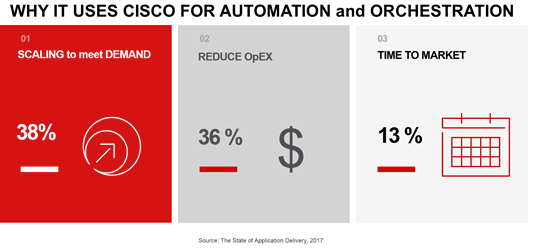Primary Author Bio – Lori MacVittie is responsible for education and evangelism of application services available across F5’s entire product suite. Her role includes authorship of technical materials and participation in a number of community-based forums and industry standards organizations, among other efforts. MacVittie has extensive development and technical architecture experience in both high-tech and enterprise organizations, in addition to network and systems administration expertise.
After a year, I am happy to back to Cisco Data Center blogs. And this time, I want to talk about DevOps.
While most of the world focuses on the digital transformation of businesses, a complementary and just as critical effort is underway within the card-key, access only halls of the data center. That transformation is also digital in nature, focusing on moving the burden of complicated network and app service deployment processes from people to technology. Technology that relies on programmability.
In the past year, the percentage of organizations using tools and frameworks to digitally transform IT into a lean, mean deployment machine more than doubled, rising from around 20% to nearly 50%. Amongst those benefiting most from that rise is Cisco, whose platforms saw its usage more than double. And not just with infrastructure and network oriented folks. Every role – from application development to security – shows a strong preference the use of Cisco’s toolsets to automate and orchestrate the deployment of network and app services necessary to ensure faster, safer application experiences for users.
Programmability implies APIs today, and that’s a good place to start. The API is the new CLI, and enables faster, smarter integration across IT in order to automate the processes that drive the deployment of everything app-related. The majority of IT recognizes the importance of programmability in general and in particular APIs; it was considered more important by only 32% of folks in 2016, but in 2017 shot up dramatically 20% to a whopping 52% of respondents in F5’s annual State of Application Delivery survey.

While DevOps focuses heavily on improve time and frequency to market by adopting application methodologies and continuous integration/delivery, NetOps has more pressing concerns that is no doubt behind these dramatic shifts in how programmability is viewed within the data center. Those concerns are primarily focused on scale and costs. Indeed, though much digital ink is given to the dearth of security talent available, little mention is given to the same deficit that exists across IT, particularly for those with IP networking skills. That gap was noted by the Global Talent Competitiveness Index 2014 at 1.2 million in 2015 and there is little chance that gap will close any time soon. In fact, Eric Roberts, former Stanford computer science department associate chair, estimates there will be a million more jobs than computer science students by 2020 (source: code.org). Which means there aren’t likely to be enough folks with the skills needed any time soon.
These are the skills that every NetOps must have whether they’re deploying network services or application services such as load balancing, app acceleration and security, or protocol gateways. Yet that deficit will undoubtedly hinder growth of the entire business. It doesn’t matter how fast app dev can build and deliver an app if production processes remain the purview of manual processes executed by a limited set of NetOps.
This is why programmability is the future of NetOps. Not because it’s going to replace them. On the contrary, there are not enough talented NetOps out there right now to fill the consoles necessary to scale to meet the demand created by business’ digital transformation efforts. No, programmability is necessary for NetOps to scale to meet demand by enabling automation and integration of the deployment processes required to implement continuous deployment’s “last mile” – the network. APIs – and increasingly templates – are critical pieces of the programmability toolset that provide the means to integrate systems across various production domains (network, security, compute, storage). They enable IT to automate the processes that provision the unique set of services each application needs to be safe, to scale to meet demand, and to execute with the responsiveness necessary to maintain the attention of an 8 year old.
Lest you think programmability has little to do with the speed of those deployments, let me assure you it does. It may not be the primary goal driving IT to digitally transformation itself with APIs and templates, but it’s a welcome and desirable side effect. Automation and orchestration of production processes necessarily compresses the time required to execute on them, which means they happen faster and, one might also conclude, more frequently if desired.
Programmability is the future of NetOps – and the network – because we’ve reached a critical tipping point in IT. We’re no longer just supporting the business, in many cases we are the business. Business lives or dies, succeeds or fails based on the ability of IT to deliver apps that scale on demand, secure data, and perform with alacrity. To deliver that at the speed of business today means not just adopting but embracing programmability to automate and orchestrate as much of IT as is possible.
I will be back in near future with a continuation of my passionate experiences with DevOps.
Related Links:
CONNECT WITH US